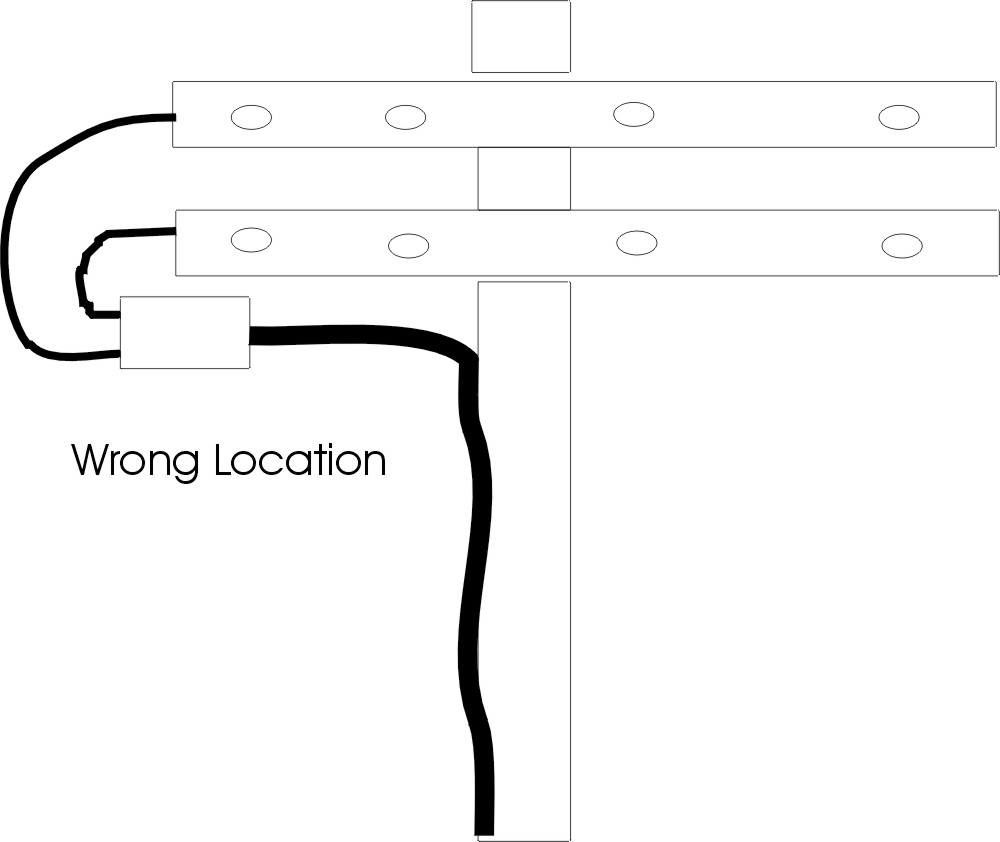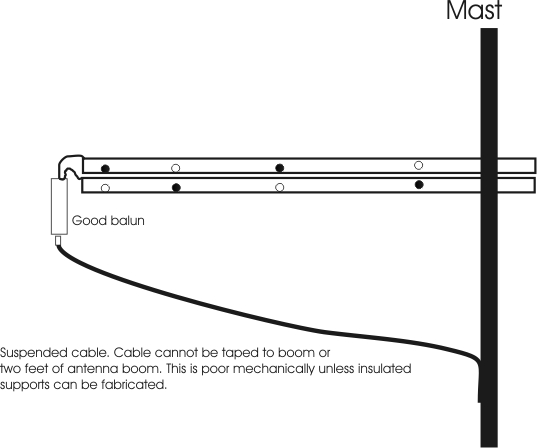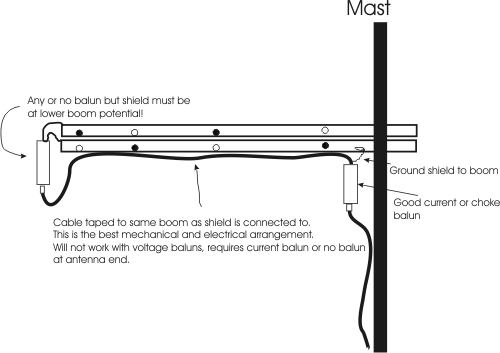|
My experience with logs is limited to some broadband commercial TV band
arrays used in MATV and CATV head ends. I worked as an independent consultant
for two companies that manufactured heavy duty multiple channel antennas for
commercial installations. In these installations, pattern and SWR was
everything. Because the antennas were used to feed video to thousands of
customers, and often installed hundreds of feet above ground, the antennas
needed clean tight patterns without ghosts caused by standing waves.
I actually became involved because some commercial antennas had ghosting and
pattern problems. These problems were related to improper feed systems. This is
a problem that appears not only in commercial TV antenna designs, amateur antenna manufacturers
also place baluns at the incorrect location in LPDA
arrays or instruct users to route the coaxial feed cable
incorrectly. This
can cause
substantial RFI and
all sorts of unusual
problems, such as excessive RF
into house wiring or consumer electronics. Improper cable routing can also cause
odd SWR problems. If we consider what the balun does, we can see how the mistake occurs.
I was first made aware of an amateur radio log periodic feed problem by a friend who had severe
consumer RFI problems whenever he ran an amplifier. The following describes what
we found.
What’s Right or Wrong with LPDA Feeds
Cold Booms
Some antenna manufacturers
suggest taping or
attaching the coaxial
feed line along the length of
the boom, back to the mast.
This would work perfectly in any antenna with a “cold” boom. The coax shield and
the boom would be at the same potential, and the boom would also be grounded
directly to the mast and tower, placing the coax shield, boom, mast and tower
all at the same RF potential, hopefully zero or near zero RF potential. These
log designs almost always have a high impedance transmission line, generally
200-300 ohms. 200 ohm systems are commonly used in transmitting arrays, through
a 4:1 balun, to a traditional 50-ohm feed cable. For receiving, balanced line
impedance is increased and the log optimized for a 300 ohm feedpoint, allowing a
4:1 balun to convert to 75 ohm cable. As a general rule though, logs work better
with lower impedance transmission lines.
Hot Booms
Some log periodic designs use the boom as one conductor of a two-conductor
balanced transmission line. This is a very good thing to do, if the system is
managed properly, because it is possible to build a very low impedance balanced
transmission line. Lower impedance balanced lines in the log tend to produce
better overall log performance. The Tennadyne log periodic is one example of a “hot boom”
antenna.
In hot boom antennas, two booms run parallel over the length of the array.
The booms are insulated, or should be insulated, from the mast and tower.
Elements alternate connection to the upper and lower, or left and right, booms.
This inverts phase, as transposing adjacent element connections in cold boom
antennas does.

A balanced transmission line, such as the balanced line feeding elements in a
log periodic, must have the following:
Equal and opposite voltages from 1 and 2 to point A, and from 1 and 2 to
point C, at each end
Equal and opposite currents in 1 and 2 at any point along the line
Equal and opposite voltages at point B all along the line
Unfortunately, some instructions route the coaxial feed line directly along
the hot boom. This is exactly like taping coax to one conductor of a balanced
open wire transmission line, because the boom is part of a two-wire transmission
line! Both booms are electrically hot, just like conductors in any balanced transmission
line. Each boom is, after
all, feeding
half the elements!! Obviously the boom cannot feed elements properly without equal and
opposite voltages, and equal and opposite currents, along each boom.

When coax is taped to the balanced boom, either balanced conductor line 2 is
forced to zero, or the coax shield is forced above ground. Actually a portion of
both happens, with the coax shield becoming a radiator and boom conductor 2
becoming more at the potential of point B.
This forces the coax to radiate and create RF ground loops, while also
starving half the log elements of voltage and current.
Any additional conductor or feed cable
paralleling the boom,
especially one held
directly against the boom by
tape or wire ties, will be significantly excited by boom currents and voltages. Cables routed
against or near the hot boom (both booms are hot when the booms are used as
transmission lines) will have the voltage difference between the boom and the
tower at the cable exit point exciting unwanted external currents in the feed line shield.
The feed line shield
will also be excited
by magnetic coupling by magnetic fields created by boom currents. In effect, the coaxial transmission line shield becomes a third transmission
line conductor, driven by boom currents and voltages through the very tight
mutual coupling.
The coaxial feed line shield is supposed to be at ground potential. It must
attach to the antenna in a way that keeps the shield at “ground potential”.
Otherwise, the shield will radiate and also bring significant RF voltage away
from the antenna. At some point we must have a properly thought-out balanced to
unbalanced transition.
As with any balanced transmission line, the hot booms (or a balanced
two-conductor line running along a cold boom) should either be symmetrically
spaced a reasonable distance in relation to the two conductors forming the balanced line, or placed
several conductor spacings away from the hot conductors that form a two-wire
balanced line. Ideally an external feed line exiting the antenna would not be
within a few feet of large diameter hot booms.
A second method that only works
with a 50 ohm feed (this will not work with 200 or 300 ohm feeds) would be to
tape the coaxial feed line along the
shield attachment
point boom and
treated like a part
of that boom.

In this example, the coaxial cable shield is much closer to the hot lower-boom
than the hot upper-boom.
We would never dream of lashing a cable, or any external conductor, to one conductor
in a two-wire balanced feed line feeding a dipole.
Commonly available information instructs us to keep all external conductors several balanced-line-widths
away from any unshielded balanced line.
There are two
ways to correct this
problem:
| Method 1.
This is a universal method for any balun style.

This is the electrically ideal method of bringing the feed line back to the
mast from the log feed. This method keeps the coaxial line away from the
balanced transmission line formed by the boom. This works with ANY
log periodic and good balun, including 200-300 ohm balanced systems.
The sole drawback with this method is mechanical. The coaxial feed line often
requires additional mechanical support, such as a non-metallic messenger
rope or an insulated rod.
If the log has a 1:1 balun at the feedpoint AND if you use a current balun, you can simply tape the coax to
the boom that the shield connects to without any balun at the log feedpoint.
Ground the coax shield to the hot boom at the exit point
where the coax leaves the boom, and install
a balun at that
point. This can be
done by installing a barrel
bulkhead feedthrough connector at the exit point and clamping
the connector to the boom.
Be sure to waterproof the assembly. The
new balun goes
between that boom
connected barrel connector and the feed line exiting the antenna boom and
running down the
tower.
|
| Method 2
This method only works with current baluns. While mechanically better, it is limited electrically to
current baluns, or no balun, at the log feedpoint. If the feedpoint balun is a
voltage balun, either use method 1 or change to a current balun.

If the beam has an impedance-matching current balun at the feedpoint,
in other words a balun with an impedance ratio other
than 1:1, the original balun must be left at the feedpoint to provide impedance
matching.
If the balun is a current balun, and cannot easily be reached, it is
perfectly acceptable to leave the
original balun at the feedpoint. Leaving
the balun at the
feedpoint
won’t bother anything so long as the balun is a current balun.
In this case, the coaxial cable is cut and a good common mode isolation device is installed
where the coaxial cable exits the boom. The isolation device can either be a 1:1 current balun,
a common mode choke, or a “feed line isolator”. All are electrical
equivalents.
At the feedpoint, the coax shield must be connected to the boom that
connects to the shield. If the coax routes through the inside of the
boom, the coax shield must be connected to the boom coax with the coax routed
inside.
In the hot-boom TV-channel log feed systems I designed, the unbalanced
coaxial feed line ran through the shield-connection boom center. The
feed line exited the boom via a feedthrough connector at a zero voltage point
along the boom. This eliminated need for any balun, and greatly
improved lightning protection.
|
Conclusion
For proper operation the feed line must be suspended at
least a few feet below the hot
booms all the way
from the balun’s
unbalanced connector
to the tower or
mast (this works with any balun and any impedance log), or a second 1:1
current or choke
balun must be added at the mast (this works most effectively or reliably when a
CURRENT balun is used at the feedpoint, or when the feedpoint requires a 1:1
balun and no feedpoint balun is used). This
will greatly reduce
RFI and improve the
antenna pattern and
gain.
 since 6/21/04 (revised 1/29/2012) since 6/21/04 (revised 1/29/2012)
© 2004 W8JI
|




